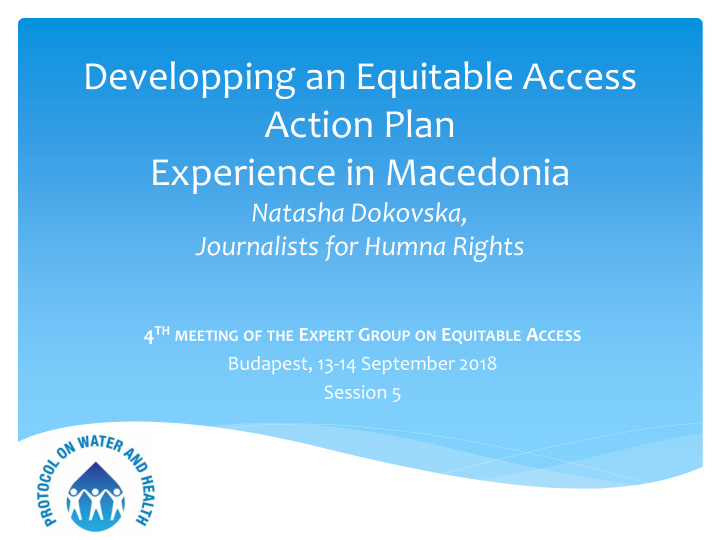



Developping an Equitable Access Action Plan Experience in Macedonia Natasha Dokovska, Journalists for Humna Rights 4 TH MEETING OF THE E XPERT G ROUP ON E QUITABLE A CCESS Budapest, 13-14 September 2018 Session 5
Rationale for developing an equitable access action plan After assessment of Score – card for equitable access to water and sanitation we are more aware that inequities still remain in Macedonia, both social and geographical (83% of access to improved sanitation in rural areas against 99% in urban area, JMP report, 2015). Lack of finance was identified as one of big probllem Missing WWWTP ( except in municipality Kumanovo) Lack of MHM in schools (except in one private school in Veles) Lack of access to drinking water and sanitation for homeless Bacteriologically improper drinking water in rural areas (20- 40%) No access to drinking water and sanitation in religious facilities
Process: developing an Equitable Access Action Plan Lead agency(ies): Journalists for Human Righst and Institute for Public Health Contributing agencies and stakeholders: Relevant Ministries ( environment, health, agriculture, forest and water management, self – governance, finance, social affaires, public institutions and water utilities companies, local communities, local NGOs and media Scale of the Action Plan: Central Macedonia was included with the municipalities of Skopje, Veles and Kumanovo with 6 municipalities Timeframe (link with other policy process?)
Process: developing an Equitable Access Action Plan Timeframe The project was scheduled to last for 5 months, from November 1, 2016 to April 31, 2017. But due to the political crisis in Macedonia, extraordinary parliamentary elections and pending local elections, scheduled for October 15, we still do not have the finalized project ... Previous activities carried out so far include: Establishing of three local teams who will work on preparation of LAP Presenting the results of the self-assessment to the respective local authorities and stakeholders, discussing possible improvements, and reaching consensus on the priorities for action; Developing draft local equitable access action Presenting the draft local action plan to local authorities and stakeholders for discussion and endorsement.
Process: developing an Equitable Access Action Plan Timeframe We still need to: - Established steering committee on national level - Acceptance of LAP by targeted municipalities - Organizing a National workshop on the development of a national equitable access action plan These activities have not been carried out so far due to the failure of the government or the municipalities.
Process: developing an Equitable Access Action Plan Timeframe But in order not to have “empty steps” from the implementation of the project, and within the current political climate in the country, we have made several activities in the direction of popularizing LAP ... First, we organized a press conference at which we presented the LAP prepared by the expert teams, we detected the priorities for each of the targeted municipalities and ask the media to push this priority as one of winning combination for them Secondly, in the preparation of the election campaign, we mobilized the local non- governmental organizations and we lobby to ask from future candidates for mayors to put in their program our priorities ... NGOs are constantly demanding from future candidates Third - official candidates should be nominated by Friday, after which we will go and meet each candidate and we will ask them to confirm that if they come to power they will elect the proposed LAP ...
Main features of the Equitable Access Action Plan Priority areas of actions Steering governance frameworks to deliver equitable access / Reducing geographical disparities / Ensuring access for vulnerable and marginalized groups / Keeping water and sanitation affordable Priority measures and related costs Analysis of plans/policies, legal and institutional reforms, changes in existing programmes, policy reforms, targeted investments, communications efforts, capacity building..
Main features of the Equitable Access Action Plan Implementation arrangements, incl. timeline To be more efficient and real, but in accordance with results from score cards, each community try to answer on: a) Targets b) Specific targets c) Strategy/Law/Plan/Program d) Actions e) Time frame (short-term 0-6m, mid-term 6m-2y, long-term 2y-5y)\ f) Responsible institution (municipality, government, PHC,PCE etc.) g) Necessary resources (municipal budget, national budget, donations) h) Indicators to track
Lessons learnt from the process Process cooperation mood for change desire to improve the situation regarding access to water and sanitation political crisis the dysfunction of the institutions inefficiency of the municipalities in the pre-election period
Adoption, communication and next steps After the completion of the local elections and the formation of councils of the municipalities will start: - Process of voting of LAP - National conference on LAP - Communication and presentation of the same to the international donor community , primarily the IPA mechanism - Negotiations with the Ministry of Local Self-Government to bring LAP into the Program for support of the eight planning regions of Macedonia - Real implementation of LAP
Recommend
More recommend